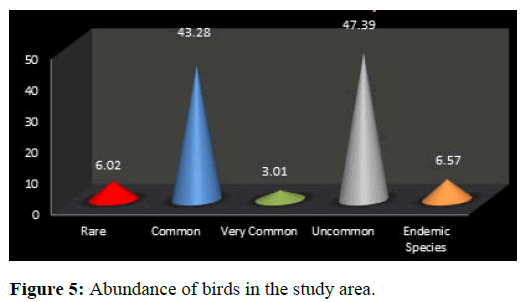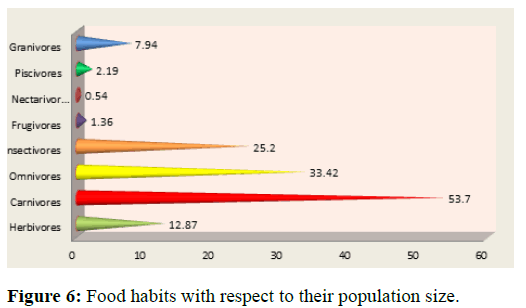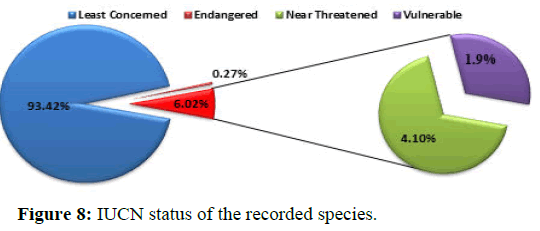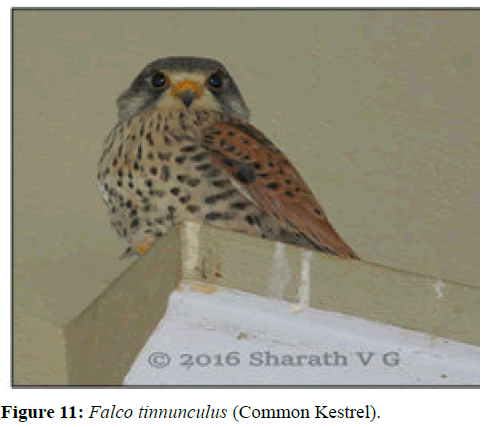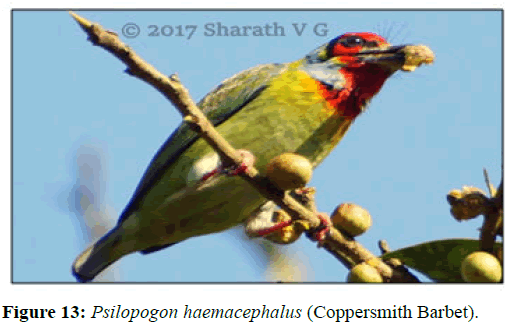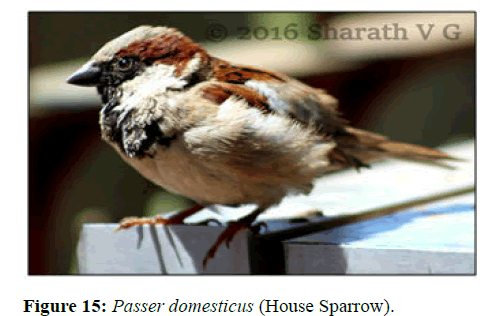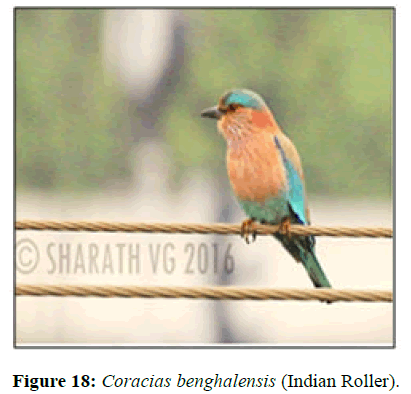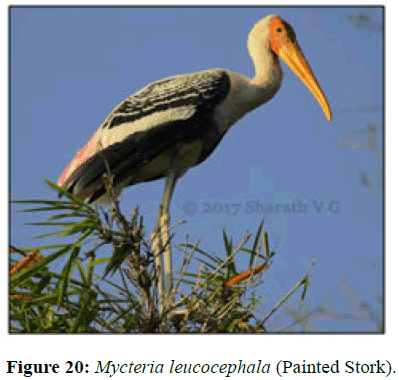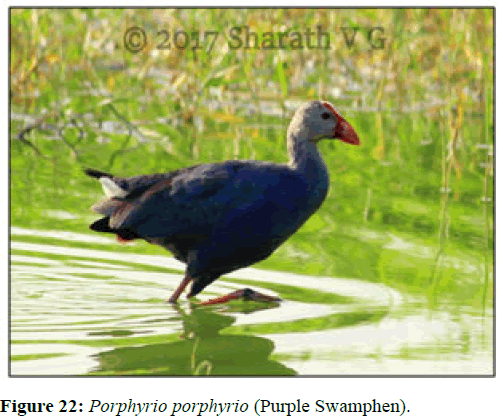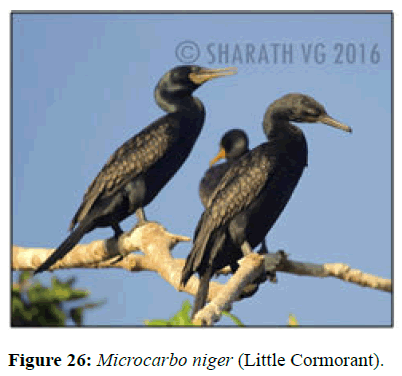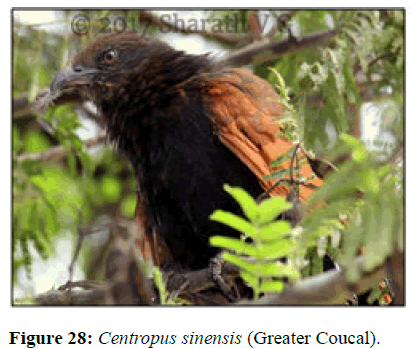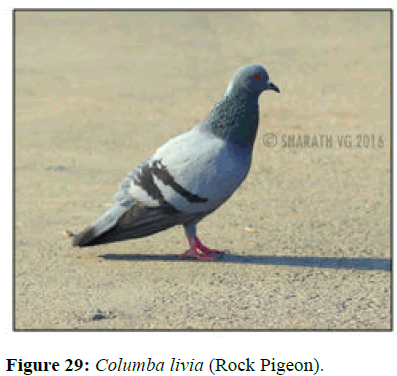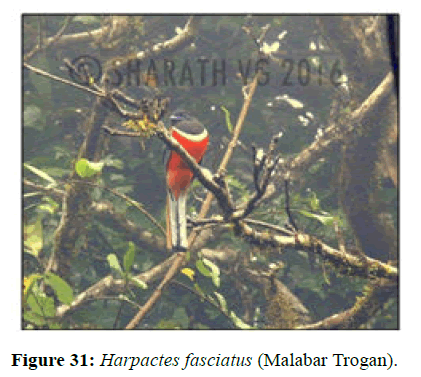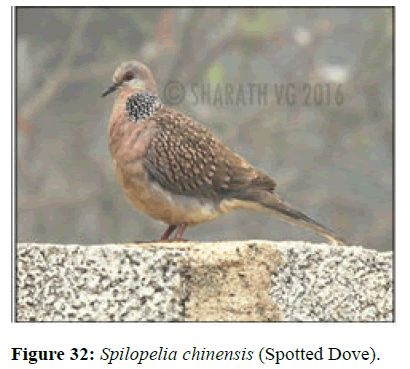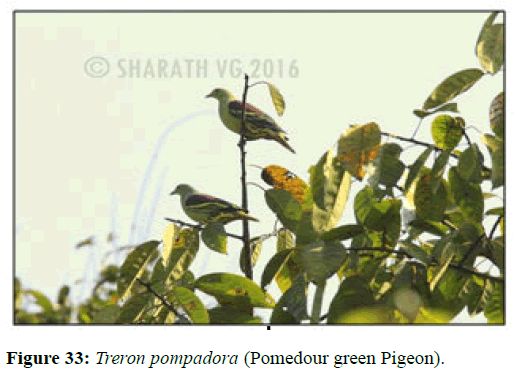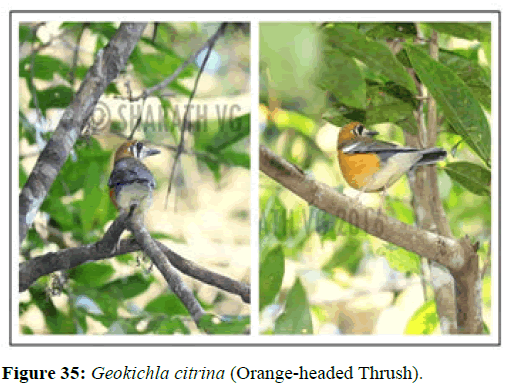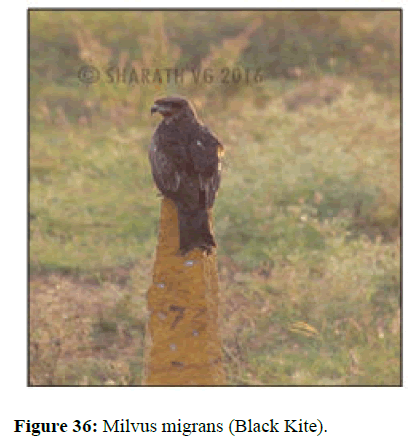Research Article, J Biodivers Manage Forestry Vol: 13 Issue: 3
Distribution and Diversity of Avifauna in Chamarajanagar District, Karnataka, India
Devi Prasad AG*
Department of Environmental Sciences, University of Mysore, Mysore, India
- *Corresponding Author:
- Devi Prasad AG
Department of Environmental Sciences,
University of Mysore,
Mysore,
India;
E-mail: agdprasad@yahoo.com
Received date: 17 September, 2019, Manuscript No. JBMF-23-2649;
Editor assigned date: 20 September, 2019, PreQC No. JBMF-23-2649 (PQ);
Reviewed date: 04 October, 2019, QC No. JBMF-23-2649;
Revised date: 13 September, 2023, Manuscript No JBMF-23-2649 (R);
Published
date: 11 October, 2023, DOI: 10.4172/jbmf 2327-4417.10050
Citation: Devi Prasad AG (2023) Distribution and Diversity of Avifauna in Chamarajanagar District, Karnataka, India. J Biodivers Manage Forestry 12:4.
Abstract
The present investigation was made to determine the avifaunal diversity and abundance in different habitats of Chamarajanagar district. This study was conducted using point count and line transects method. The distribution of the birds based on its nutritional behavior was also attempted. A total of 365 birds belonging to 75 families and 19 orders were recorded. Among these 275 residents, 80 migrants and 8 winter migrants were recorded. Passeriformes is the predominant order observed in the area. The population of the avifauna is in peril owing to anthropogenic disturbances. The present statuses of these birds have been documented.
Keywords: Avifauna, Diversity, Chamarajanagar, Passeriformes
Introduction
Global biodiversity envisages the most important colorful component, the avifauna. The study of avifaunal diversity is an essential ecological tool which provides a wide range of environmental and social functions which include biomass recycling, pollination, disease regulation and dispersal of fruits and seeds. Birds fulfill many ecological functions in their habitats. They are integral part of food chain and food web. They are helpful and help to provide rich food for mankind and are known to man since ages. They are the best monitors of an environmental change helping in understanding the quality of habitats. Monitoring of birds provide valuable information on the status of ecosystem health. Thus protection and maintenance of avifaunal diversity is important in maintaining species diversity of plants and animals. Birds are among the best monitors of environmental changes and have been used to evaluate the environment throughout the history as ‘bio monitors’ and; the changes in their population, behavior pattern and reproductive ability have most often been used to examine the long term effects of habitat fragmentation. The avian habitat is roughly divided into forest, scrub and wetlands, all though many species require a mixed type of habitat. The Indian subcontinent is very rich in biodiversity. Out of more than 9000 birds of the world, the Indian subcontinent contains about 1300 species or over 13% of the world’s birds. As far as avian diversity of India is concerned, many workers have done a lot of work on this regard. While many common species are spread over large areas of the Indian subcontinent others may be limited to a region. Since the subcontinent has a dense population, the birds which adapt themselves to human habitat flourish well. In Karnataka most of the work is being concentrated on survey, distribution, diversity and status of avifauna in different bio regions of the selected districts of the state. However, no significant work has been made in the western ghats parts of Chamarajanagar district regarding the diversity, distribution pattern, abundance, population trends, feeding behavior and present status of avifauna. In view of this the present study was made, focusing on the said parameters.
Materials and Methods
Study area
Chamarajanagar lies in the southernmost part of Karnataka, India and is located at latitude-11° 92' North and longitude-76° 95' East. Being the southernmost part of Karnataka, Chamarajanagar area fringes the parts of Tamil Nadu and Kerala. In particular, it connects Mysuru area of Karnataka toward the West and North, Mandya and Ramanagara regions toward the North-east, Dharmapuri of Tamil Nadu towards the East, Salem and Erode regions of Tamil Nadu to South-east, Nilgiris of Tamil Nadu towards south and Wayanad region of Kerala toward the South-west [1]. The vast majority of the district lies on the leeward side of the Nilgiris and comprises of chiefly semidry rainfall dependent flat areas alongside forested slopes. Of the 622 wetlands of Karnataka as many as 22 wetlands are present in Chamarajanagar district (Figure 1).
In the present study, 30+ different habitats of Chamarajanagar district were selected after surveying and random sampling of the forest area. The selected places were monitored in each month of the year for locating the avifauna.
The study was carried out at periodically during 2015-2017 and the checklist was regularly updated. The photographs and the field visit reports were used as evidences for updating the checklist. As the habitats varied considerably, the avifauna was assessed using both point count and line transect methods (variable width line transect method. The point count method which was adapted for wetland birds had a fixed radius of 30 m. About 45-60 minutes were spent at each point in the count site. About 4-5 transect line each measuring approximately a length of 300 m were plotted. The transect lines were walked at a uniform and observations were made at each transect line for about 45-60 minutes. Birding was done in the early hour’s i.e., from morning 6.30 AM to 10.00 AM and also 16.00 to 18.30 in the evening. A questionnaire was prepared to gather information from the local inhabitants/tribes on our path. All the observed birds in the site were roughly enumerated and recorded in a standard field data sheet. Physical parameters such as temperature, cloud cover, wind, humidity etc were recorded. About 80-100 transects lines were laid for the observation of birds [2]. Point count method was carried out on the banks of lakes, rivers, steep areas and other places where transect method couldn’t be carried out.
Birds were sighted using a 10 × 50 wide angle celestron binocular and the birds were photographed using canon 60d and 600d cameras using three different lens: i) 18 mm-135 mm, ii) 55 mm-250 mm, iii) Tamron 150 mm-600 mm telescopic lens. Birds were identified with the help of local bird watchers, farmers and amateur wild life photographers. The identification was confirmed by authentic scientific literature and monographs on birds. Names of known birds whose calls were clearly audible were listed. Calls of unknown nonvisualized birds were recorded and identified later with the help of bird experts, internet and android application bird sounds and Indian birds. Birds which couldn’t be identified on spot were either photographed or key identification characters were noted and identified using felid guides namely:
• The book of Indian sub-continent by Dr. Salim Ali.
• Common birds of Indian sub-continent by Ananda Banerjee.
• Hakki Pukka by Poorna Chandra Tejaswi.
• Illustrated encyclopedia of birds by word life.
The birds were categorized according to their respective status as Residents (Re), Migratory (M), Resident Migratory or local migratory (ReM), Winter Migratory (WM), Very Common (VC), Common (C), Rare (R), Very Rare (VR) and the trends of population was determined by analyzing the regularly updated checklist of two years [3]. The bird species were further catalogued.
Results and Discussion
A diverse population of birds has been identified in Chamarajanagar district during the study period (2015-2017). The study reveals the occurrence of 365 species of birds belonging to 19 orders of 78 families [4]. A total of 365 birds belonging to 19 orders and 78 families have been identified in the current study which includes 275 resident birds and 90 migratory birds (Figure 2).
It was noted that Passeriformes (42.73%) followed by Charadriiformes (9.31%) and Pelicaniformes (8.76%) were the dominant orders among the study sites. The other orders of avifauna such as Piciformes (4.65%), Acciptriformes (4.38%), Cuculiformes (4.10%), Columbiformes (3.83%), Galliformes (3.83%), Anseriformes (3.56%), Coraciformes (3.28%), Caprimulgiformes (3.01%), Gruiformes (2.46%), Bucerotiformes (1.36%), Psittaciformes (1.36%), Ptercoliformes (0.81%), Falconifornes (0.82%), Strigiformes (1.64%), Trogoniformes (0.27%), Phoenicopteriformes (0.27%) were also recorded (Figure 3).
Of 365 bird species documented, 36.43% (133 species of birds) are maintaining stable population. A decreasing population of the species by 43.56% (159 species) is also recorded. Only 9.31% (34 species) of the species was found to show an increasing population. A significant observation in the present study is that the population trend of 39 species of birds could not be analyzed as the data available was insufficient due to lack of investigations in the region (Figure 4).
The occurrence status of the avifauna showed 47.39% of birds to be uncommon, 43.28% to be common, 6.02% to be rare and 3.01% to be very common. Among these 6.57% of the bird species are endemic to the region (Figure 5). The very common avian species sighted in the area include spot-billed duck, orange-breasted green pigeon, rock pigeon, crow pheasant, Indian spotted eagle, black kite, rose-ringed parakeet, black drongo, house crow and jungle crow [5].
The endemic species recorded include red spurfowl, jungle bush quail, rock bush quail, painted bush quail, grey jungle fowl, red spurfowl, painted spurfowl, malabar trogan, brown-headed barbet, malbar parakeet, oriental skylark, rufous-tailed finch lark, grey-headed bulbul, yellow-throated bulbul, white-bellied flycatcher, niligiri verditer flycatcher, tytler’s leaf warbler, rufous babbler, wayanad laughing thrush, white-bellied treepie, crimson-backed sunbird, whitenaped tit.
In the present study, a decline in the population of most of the species is due to the below mentioned reasons:
• Developmental activities such as road extension, construction of
bridges and construction of huts/houses by the villagers.
• Encroachment of forest land due to shifting cultivation by the
inhabitants on the fringes of the forest.
• Poaching and selling of song birds as these birds area being used as
pets.
• Hunting of flightless birds for flesh by humans and also by the
predators.
• The eggs of certain birds such as red/yellow watlled lapwing are
known to have medicinal potential and as such used by the local
medicine practitioners of the village. Hence some people steal the
eggs of these birds and market it for such practitioners.
• The flesh of a few birds such as grey partridge (Teetar), jungle fowl,
jungle quail, bush quail, red spurfowl, spotted pigeon, rock pigeon
are most popularly consumed by the locals owing to the belief that
these birds are good for health and gives strength.
• Sole dependence of food option by many of the birds (piscivorous,
granivorous etc are solely dependent on fishes and grains
respectively). The depletion in the food sources causes immense
pressure which in turn leads to the depletion of bird population as
they migrate elsewhere.
• Anthropogenic activities such as pollution especially noise
pollution, frequent vehicular movement and habitat disruption due
to construction activities have disturbed the occurrence and
distribution of these birds.
• Climatic variation in the past recent years.
Regarding the nutritional status of the avifauna of the study area, we recorded that about 33.42% are omnivorous (insects, nectar, grains, seeds, fruits, reptiles, fishes etc), 12.87% are herbivorous (grains, seeds, sea plants, weeds, nectar and etc), 33.42% are carnivorous (fishes, reptiles, insects, cocoons, amphibians, small birds etc) respectively [6]. It is observed and recorded that carnivorous birds are dominating in the area as compared to the species specific for particular nutrients such as granivorous, piscivorous, nectarivorous and frugivorous. Omnivorous species rank second in domination over other species in the region (Figure 6).
Of the total 365 bird species documented in the study area 127 bird species inhabiting forest (33.42%) belonging to 37 families, 93 species of wetland birds (25.47%) belonging to 19 families, 67 species inhabiting mixed type of habitats (18.35%) belonging to 21 families and 78 bird species of other habitats belonging to 26 families have been recorded from the study area [7]. The species occurring in other habitats include 1.09% of bird species in croplands, 1.36% of bird species in grassland, 4.1% of bird species in human settlement areas, 12.6% of bird species in in scrublands and 3.91% of bird species in gardens, dry lands and reed beds (Figure 7) [8-10].
The study area also revealed that there are 24 endemic species and 24 threatened species (6.57% each) [11-13]. Regarding the IUCN status of the bird species in the study area, the study revealed the presence of near threatened species (4.1% with 15 species), vulnerable species (1.9% with 7 species), endangered species (0.27% with 2 species) and least concerned species (93.42 with 341 species) (Figure 8) [14,15].
Some of the species of Chamarajanagar district during the field exploration are given below (Figures 9-44).
Conclusion
The study areas of Chamarajanagar district show semi-arid condition with less annual rainfall (average 751 mm). Though most of these areas are dependent upon rainfall, the region supports a good number of wetlands and sustenance of wetland birds. The evaluation of the study area showed different habitats having rich avian diversity this is due to availability of varieties of food resources. Species richness in an area is dependent on the availability of food, evolutionary history and predation pressure. Also, it is well established fact that, diversity indices are dependent on two factors, species richness and evenness which are directly co-related to stability of ecosystem. Significant observation was made during the study has shown that though the area is showing the avian species richness, their population size is moderate to low. Various environmental factors and anthropogenic activities are the major factors governing the population size of these bird species. The degree of threat to these species resulting in their fluctuations is also increasing due to developmental activities of the area.
This study will provide factual data about the present status of the avifauna in the district which offers scope for future management and implementation of conservation programs.
Acknowledgement
I am thankful to Mr. Abhishek Bharadwaj, Mr. Gireesha J, Mr. Abhishek MR and the villagers of Chamarajanagar district for helping during the field exploration. I would like to express my special thanks and gratitude to Mrs. Shruthi, Mr. Varun, Mrs. Sabike Noobia and Ms. Annapoorna KP and my parents for supporting me in making this endeavor a reality.
References
- Burnham KP, Anderson DR, Laake JL (1981) Line transect estimation of bird population density using a fourier series. Stud Avian Biol 6: 466-482.
- Jayson EA, Mathew DN (2000) Diversity and species abundance distribution of birds in the tropical forests of silent valley, Kerala. J Bombay Nat Hist Soc 97: 390-399.
- Harisha MN, Hosetti BB (2009) Diversity and distribution of avifauna of Lakkavalli range forest, Bhadra wildlife sanctuary, western ghat, India. An Int J Ecol 16: 21-27.
- Ramchandra AM (2013) Diversity and richness of bird species in newly formed habitats of Chandoli National Park in western ghats, Maharashtra state, India. Biodiv J 4: 235-242.
- Singh R, Jaiswal A, Singh J, Singh N, Bhaskar SK (2018) Study of bird diversity in Gorakhpur university campus. J Biodiv Endanger Spec 6: 2.
- Venkitachalam R, Vijayan V (2020) Status and diversity of bird species in government college campus in Chittur of Palakkad, Kerala. Kongunadu Res J 7: 1-4.
- Adhurya S, Gayen D, Chakrabarty M, Singha Roy U (2023) A study of avian diversity in Durgapur government college campus, West Bengal, India. Holistic Appr Env 13: 48-62.
- Dey A, Deb D, Chaudhuri SD, Chaudhuri P (2014) A preliminary study on avifaunal species diversity of Maharaja Bir Bikram college campus, Tripura, North East India. Int Multidiscip Res J 3: 36-43.
- Dorlikar A, Charde P (2019) Studies on avian diversity, abundance and their status at Raj Bhavan, Nagpur, Maharashtra. Int J Adv Sci Res Manag 4: 21-27.
- Bhattacharya R, Roy R, Das R (2013) Diversity and distribution of local birds beside the tropic of cancer. Int J Environ Sci 3: 1322.
- Altaf M, Javid AR, Irfan MA, Munir SA, Iqbal KJ, et al. Diversity, distribution and ecology of birds in summer season flathead Khanki, Punjab, Pakistan. Biologia 59: 131-137.
- Mistry J (2015) Avifaunal diversity in and around Berhampore, Murshidabad district, West Bengal, India. Int J Fauna Biol Stud 2: 6-10.
- Sunil C, Somashekar RK, Nagaraja BC (2011) Impact of anthropogenic disturbances on riparian forest ecology and ecosystem services in Southern India. Intern J Biodiv Sci 7: 273-282.
- Mallegowda P, Rengaian G, Krishnan J, Niphadkar M (2015) Assessing habitat quality of forest-corridors through NDVI analysis in dry tropical forests of south India: Implications for conservation. Remote Sensing 7: 1619-1639.
- Variar AS, Anoop NR, Vinayan PA, Ajayan PA, Sujin NS, et al. Resident birds show different patterns in species composition and functional diversity in differently managed coffee plantations in the Western Ghats, India. Ornithol Sci 20: 185-199.
 Spanish
Spanish  Chinese
Chinese  Russian
Russian  German
German  French
French  Japanese
Japanese  Portuguese
Portuguese  Hindi
Hindi 



